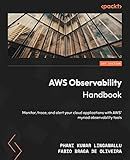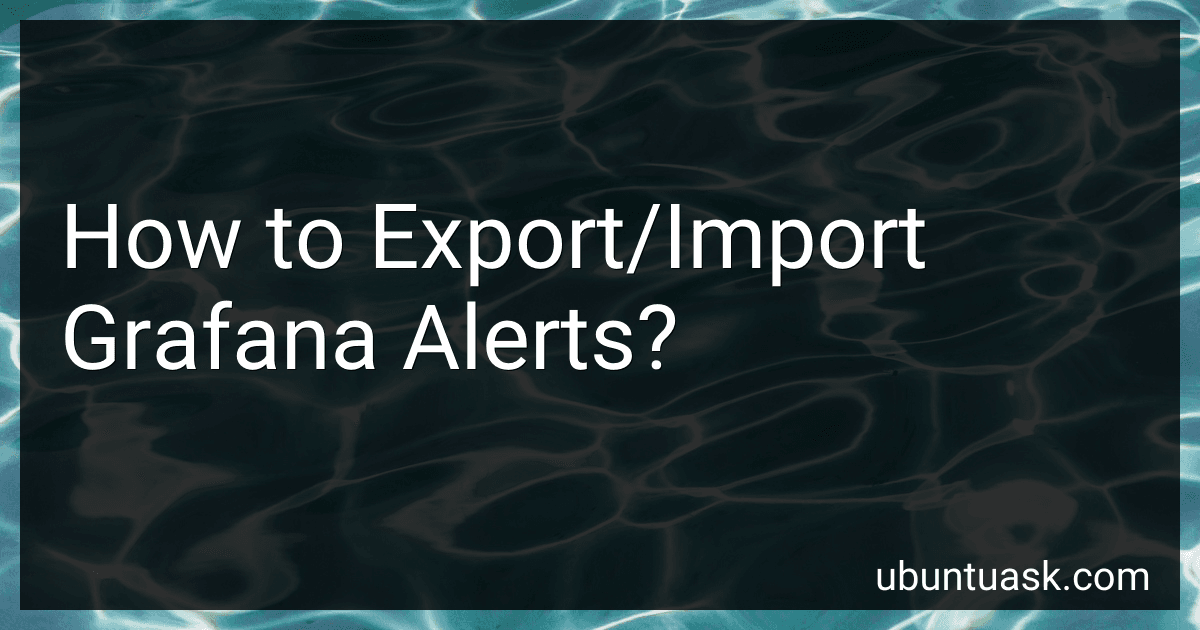Best Tools for Grafana Alert Management to Buy in December 2025

Modern Network Observability: A hands-on approach using open source tools such as Telegraf, Prometheus, and Grafana



Observability with Grafana: Monitor, control, and visualize your Kubernetes and cloud platforms using the LGTM stack



AWS Observability Handbook: Monitor, trace, and alert your cloud applications with AWS' myriad observability tools



Open Source Network Management: A Guide for getting started with Open Source Tools to manage your network.


Exporting and importing Grafana alerts can be done using the Grafana API or by using the Grafana web interface. To export alerts, you can use the Grafana API to fetch the alert definitions in JSON format. Once you have the JSON data, you can save it as a file on your local machine.
To import alerts, you can use the Grafana web interface to upload the JSON file containing the alert definitions. You can then review and modify the imported alerts as needed before saving them to your Grafana instance. Additionally, you can also use the Grafana API to programmatically import alert definitions into Grafana.
It is important to note that exporting and importing alerts requires appropriate permissions in Grafana to manage alerts. Make sure you have the necessary permissions before attempting to export or import alerts.
How to backup Grafana alerts for safekeeping?
To back up Grafana alerts for safekeeping, you can follow these steps:
- Log in to your Grafana instance.
- Go to the Alerts section in the left sidebar menu.
- Click on the "Alert Rules" tab to view all of your alert rules.
- Select the alerts that you want to back up by clicking on the checkboxes next to each alert rule.
- Click on the "Export" button at the top of the page.
- Choose a location on your computer to save the exported file, and click "Save".
- This file contains all the alert rules that you selected, and you can use it to import the alerts back into Grafana if needed.
Alternatively, you can also use the Grafana API to export and backup the alert rules programmatically. You can refer to the Grafana documentation for more information on how to use the API for exporting alerts.
What is the difference between exporting alerts and exporting alert rules in Grafana?
Exporting alerts in Grafana allows users to export the current alert configuration, including the list of configured alerts, alert thresholds, and notification channels. This is useful for backing up and sharing alert configurations between instances of Grafana.
On the other hand, exporting alert rules in Grafana allows users to export the raw alert rule definitions in JSON format. This includes all the details of each alert rule, such as the query, thresholds, and notification channels. Exporting alert rules is useful for advanced users who want to fine-tune alert configurations or automate the creation of alert rules using external tools.
How to modify exported Grafana alerts before importing?
To modify exported Grafana alerts before importing, you can follow these steps:
- Export the alerts from your Grafana instance by going to the Alerts tab in the Grafana UI and clicking the Export button.
- Save the exported JSON file to your local machine.
- Open the exported JSON file in a text editor or IDE.
- Make any necessary modifications to the alert configurations in the JSON file. You can modify properties such as the alert name, alert conditions, alert thresholds, and notification settings.
- Save the modified JSON file with your changes.
- Import the modified JSON file back into your Grafana instance by going to the Alerts tab in the Grafana UI and clicking the Import button.
- Select the modified JSON file from your local machine and click the Import button to upload the updated alert configurations.
By following these steps, you can modify exported Grafana alerts before importing them back into your Grafana instance with the desired changes.
How to export specific Grafana alerts based on criteria?
To export specific Grafana alerts based on criteria, you can follow these steps:
- Log in to your Grafana instance and navigate to the Alerts page.
- Use the search bar to find the alerts that match your criteria. You can search by alert name, tags, or any other criteria that you have set up for your alerts.
- Select the alerts that you want to export by checking the boxes next to them.
- Click on the "Export" button, which is usually located at the top or bottom of the alerts list.
- Choose the export format for your alerts. Grafana usually supports exporting alerts in JSON format, which can be easily imported into other monitoring tools or platforms.
- Click on the "Export" button to download the alerts in the selected format.
- You can now use the exported alerts in other systems or platforms as needed.
By following these steps, you can easily export specific Grafana alerts based on your criteria and use them in other monitoring tools or platforms.
How to import Grafana alerts into a new installation?
To import Grafana alerts into a new installation, you can follow these steps:
- Export alerts from the existing Grafana installation:
- Log in to the Grafana web interface of the existing installation.
- Go to the Alerting section by clicking on the bell icon in the side menu.
- Click on the "Alert Rules" tab to view all alert rules.
- Select the alerts you want to export by checking the boxes next to them.
- Click on the "Export" button at the top of the page to download a JSON file containing the alert definitions.
- Transfer the exported JSON file to the new Grafana installation:
- Move the JSON file to the new Grafana server using a file transfer method like SCP or SFTP.
- Import alerts into the new Grafana installation:
- Log in to the Grafana web interface of the new installation.
- Go to the Alerting section by clicking on the bell icon in the side menu.
- Click on the "Manage" tab and then select "Import" from the dropdown menu.
- Choose the exported JSON file from your local file system and click on the "Upload" button.
- Review the imported alerts and make any necessary adjustments to settings or recipients.
- Save the changes to apply the imported alerts to the new Grafana installation.
By following these steps, you can easily import Grafana alerts from one installation to another and ensure that your monitoring and alerting configurations are consistent across environments.
